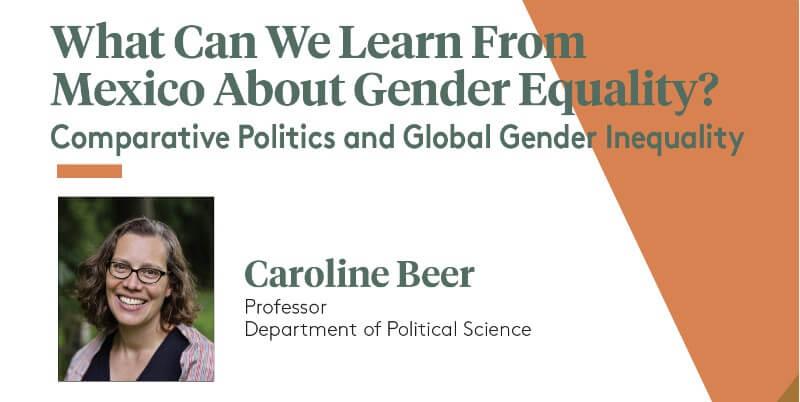Professor of Political Science Caroline Beer delivers the next College of Arts and Sciences Full Professor Lecture on Wednesday, September 18, at 4:30 p.m. in Waterman’s Memorial Lounge. Beer’s lecture explores the central question of what the study of Mexico and comparative political analysis can teach us about gender inequality. Mexico was at the forefront of progressive gender legislation in the early twentieth century after the triumph of its anti-clerical revolution. Again in the early twenty-first century, after its transition to democracy, Mexico enacted wide-ranging gender equality policies. Women in Mexico enjoy greater equality in many spheres of life than women in the United States.
Mexico appears to be quite progressive compared to the United States as far as gender equality.
Yes, looking at gender equality in measurable ways, Mexico does a lot better than the United States. For example, Mexico passed an equal rights amendment in 1974, which the United States still hasn’t passed. In both countries the debate was about adding a simple line in the Constitution that states men and women were equal before the law—Mexico added this clause in 1974. Mexico also has no-fault divorce, which provided alimony settlements to women starting in 1914. By contrast, the first no-fault divorce in the U.S. was in California in 1969.
What about representation in government?
Mexico has a constitutional requirement that no more that 50% of candidates from any party for any legislature in the country can be of the same gender—basically it’s called a parity quota . . . It turns out men are still more likely to win elections, in part because parties often put women in seats they know won’t be competitive. Still, 48% of the current legislature in Mexico is female; in the U.S. it’s 23%. So that’s a huge difference in formal representation. The current president of Mexico has adopted a “parity cabinet” where he appoints an equal number of men and women which is following a growing trend in Latin America. By contrast there are only two women in the Trump cabinet.
One might think the strong influence of the Catholic Church might be a counterweight to reform?
For most of the 1800s there were ongoing civil wars in Mexico between conservatives and liberals which were ultimately about the role the church would play in the public sphere. Conservatives wanted to maintain a European Monarchy with a fusion of the Catholic Church and the government. They were successful briefly when they brought over Maximillian von Hapsburg to rule as monarch. The liberals eventually won out—their leader was Benito Juarez, a George Washington-type figure in Mexico. He was the one that enacted this liberal constitution which set the stage for a secular government that removed the power of the Catholic Church in dramatic ways from Mexican politics . . .
Among other things, the new laws ended all punishment for sodomy. Abortion remained a crime, but they dramatically reduced the penalty—under the conservative government an abortion sentence meant hard labor for life. Under the liberal constitution the penalty was two-year imprisonment . . .
The problem in Mexico is that the laws are not always fully implemented—there isn’t always a strong rule of law. So marginalized people are not as protected by the law as they would appear to be on paper.
What about reproductive rights?
I read all of the debates in the Mexican Congress and not once did any member of the Catholic party make arguments that abortion should be illegal because of religion–any kind of religious argument would be considered completely unacceptable. The arguments that Catholics make in Mexico is that you have to protect the rights of the disabled. In most parts of Mexico you can have an abortion if the fetus is compromised in some way–and so one of the big arguments against abortion is the rights of the disabled. They never refer to religious doctrine in their arguments because of the strong separation of church and state.
These contrasts must be to eye-opening to your students.
I study comparative politics—the basic premise of the field is you can’t understand anything in isolation. I make the point to students that in order to really understand yourselves, you need to understand others. If you wanted to assert that the U.S. is the greatest democracy in the world–well, you won’t have enough data to make that statement until you know a lot more about other democracies. Without more information, you can’t make that statement as a scientist.
For me the big questions in politics are ‘why are some countries democratic and others not?’ ‘What causes countries to transition from non-democratic to democratic systems?’ ‘What’s the nature of differences among democracies?’
Professor Beer first travelled to Latin America as a sixteen-year-old foreign exchange student in Ecuador. Since then she has returned as often as possible. Her early research examined the local dimensions of Mexico’s transition to democracy. More recently, she has published articles about gender quotas, abortion policy, violence against women laws, and LGBT rights in Mexico.
